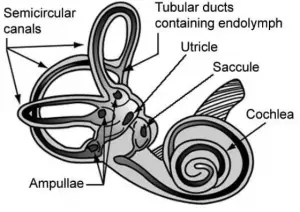Motion or travel sickness – known medically as kinetosis – can ruin even the best planned journey. So what causes this debilitating condition and what can you do about it?
The cause of travel sickness
 Motion sickness is a form of nausea that is triggered while travelling by car, sailing at sea or riding on other forms of transport in which the level of motion detected by the inner ears does not match the degree of movement seen by the eyes. Lawrence of Arabia, for example, was said to experience motion sickness when riding a dromedary, and it can also occur in astronauts during weightlessness in space.
Motion sickness is a form of nausea that is triggered while travelling by car, sailing at sea or riding on other forms of transport in which the level of motion detected by the inner ears does not match the degree of movement seen by the eyes. Lawrence of Arabia, for example, was said to experience motion sickness when riding a dromedary, and it can also occur in astronauts during weightlessness in space.
In its mildest form, motion sickness may only cause a feeling of uneasiness and nausea which may be accompanied by a headache or dizziness. In more severe cases, it can cause sweating, salivation, flushing, vertigo, over-breathing and profuse vomiting together with extreme distress.
How motion is detected
The inner ear is known as the labyrinth. It contains a convoluted, jelly-like structure (membranous labyrinth) filled with fluid. One end of the membranous labyrinth is involved in hearing, while the other end contains the structures involved in balance, which are:
- Three fluid-filled semi-circular canals
- The utricle
- The saccule.
The semi-circular canals detect rotational movement and are rather like three spirit-levels orientated at right angles to each other. One end of each canal carries a swelling (ampulla) containing a cluster of motion-detecting cells that have 30 – 150 hair-like projections on their surface. Rotational movement causes swirling of the fluid in the canals which causes these ‘hairs’ to bend.
The utricle and saccule also contain clusters of hair cells, over which lies a membrane embedded with tiny crystals of calcium carbonate. These crystals (otoliths) are displaced by movement in any direction, and motion is detected when they brush against the hair cells to displace their hair-like projections. The utricle is mainly sensitive to horizontal movement (forwards, backwards and side to side) while the saccule detects vertical movement (up and down).
Once motion is detected, the hair cells send an electrical signal to part of the brain (flocculonodular lobe of the cerebellum) for analysis. Nerve fibres from this part of the brain than pass to another part of the brain concerned with the control of eye movement.
Travel sickness is caused by excessive and repetitive stimulation of the hair cells in the inner ears when the brain receives conflicting messages from the eyes that do not match the degree of movement detected by the inner ears. This is especially likely when travelling in a closed space such as a car, where you tend to focus on objects inside the vehicle. Your eyes tell your brain the environment is stationary, but your balance organs say it is not. If there is good visual evidence of the head’s position – as in cycling or skiing for example – motion does not usually trigger travel sickness.
Everyone is susceptible to travel sickness
We are all susceptible to travel sickness, but we each have a different sensitivity, possibly related to the degree of symmetry between our right and left inner ears. Researchers have found that one in three people are highly susceptible to motion sickness, another third only suffer during fairly rough conditions, while the remaining, lucky one in three only react during prolonged, violently rough conditions.
Very young children seldom suffer from car sickness as the nerve pathways involved are not fully developed. By the age of ten years, however, children are especially susceptible.
Some research also suggests sensitivity to motion varies according to hormone levels during the menstrual cycle, with the greatest susceptibility for women occurring just before ovulation.
Other factors that can make travel sickness worse include:
- anxiety
- fear
- stuffy atmosphere
- exhaust or diesel fumes
- having a full stomach
- the sight or smell of food.
Sensitivity to motion sickness can be reduced by rehabilitation programmes such as those designed to desensitise airforce personnel against air-sickness. Rehabilitation courses last two weeks in which subjects undergo increasingly more intense and varied nausea-inducing stimulation, as well as cognitive-behavioural therapy. The success rate is as high as 88%.
Best travel sickness tablets
A number of travel sickness remedies are available and are best taken before travel, as it is easier to motion sickness than to treat nausea once it has developed.
The drug, hyoscine, is available on prescription and can be taken by mouth 30 minutes before travel as a tablet, or applied as a patch (Scopoderm TTS) behind the ear, 5 to 6 hours before travelling. Possible side effects include dry mouth, dizziness, blurred vision and difficulty passing water.
Antihistamines are also highly effective. Most people prefer less sedating antihistamines such as cinnarizine, which is better tolerated.
Cinnarizine (eg Stugeron) is my travel sickness tablet of choice. It is highly effective in treating motion sickness as it works in two ways:
- on the vomiting centre in the brain to stop nausea
- on the balance organs in the inner ear to reduce sensitivity to motion.
Unlike other commonly used travel sickness tablets which only work for 4 – 6 hours, Stugeron works for at least 8 hours to reduce susceptibility to motion sickness and can see you through a whole day’s journey. For travellers who are already feeling sick, or who have vomited, Stugeron can be sucked rather than swallowed for a more rapid onset of action. It does not tend to cause drowsiness and does not cause dry mouth, blurred vision or dizziness. In clinical trials, 96% of children tested benefited from taking Stugeron, with 86% remaining alert or only slightly drowsy.
A study involving yachtsmen found that 88% of yachtsmen rated Stugeron as better than other treatments and 94% said they would use Stugeron again. My teenagers swear by Stugeron as it prevented nausea even on a very rough ferry trip that lasted for six hours, when everyone else was very ill indeed.
Ideally, take it two hours before a journey. For travellers who are already feeling sick, or who have vomited, however, it can be sucked rather than swallowed for a more rapid onset of action. Stugeron is available from Boots.com for shipping worldwide.
Ginger for travel sickness
Ginger has excellent anti-nausea properties and is believed to work by lowering levels of a hormone, vasopressin, and by regulating abnormal contraction of the stomach. Drink ginger tea, ginger beer, chew crystallised ginger, ginger gum, or take ginger capsules. You could also place a few drops of ginger essential oil on a hanky to inhale.
Travel sickness bands
Acupressure bands that stimulate the P6 acupuncture point on the wrist can also relieve motion sickness. Elasticated wrist bands or disposable acupressure plasters are especially useful for children. Research suggests that are as effective in decreasing symptoms of motion sickness as oral medication, but without possible side effects such as drowsiness or dry mouth. The most effective bands are based on electroactupressure, and devices stimulate the acupoint with a tiny electrial signel that is clinically proven to reduce vomiting and nausea. These bands and anti-emetic devices are used to reduve morning sickness during pregnancy, too.
Rescue remedy for travel sickness
Flower essences are useful during times of stress, and a few drops or a spray on the tongue can help you relax and feel better. Bach Rescue Remedy is a pre-mixed combination of Rock Rose, Impatiens, Clematis, Star of Bethlehem and Cherry Plum in a base of grape alcohol (brandy). These flower remedies are intended to help counter the effects of stress and shock to help you gain control.
Rescue Remedy is available as drops, an oral spray, liquid melts, pastilles and lozenges. For use during travel, the spray and lozenges are ideal. You can see the full range on Amazon.co.uk or on Amazon.com.
Travel sickness tips
- Start travel sickness treatment before travelling
- Prepare for your journey in advance so you stay relaxed – avoid over-anxiety and last-minute panics
- Only eat light meals before and during travel
- Avoid alcohol
- Avoid stuffy or fume-laden atmospheres
- Sit or stand where plenty of fresh air is circulating eg open a car window
- In a bus or coach, choose a seat between the wheels where movement is less
- In an aeroplane, sit in the area over the wings
- Avoid focusing on near objects – reading a book or looking at a map when travelling in closed quarters can trigger nausea.
- Look at a point on the distant horizon – for example, when travelling by sea, stay on deck scanning the horizon
- Make sure children sit high enough to see out of the window (in a child’s car seat if applicable)
- An adult with car sickness can try being the driver rather than the passenger – drivers seldom suffer from car sickness as they are concentrating on the outside of the car (NB Do not take a travel medication that can cause drowsiness when driving or when operating machinery)
- Stop to stretch your legs regularly – or walk up and down the aisle in a plane or bus.
Be prepared
Essentials for your travel first-aid kit:
|
Image credits: Pixabay; NASA/wikimedia;





